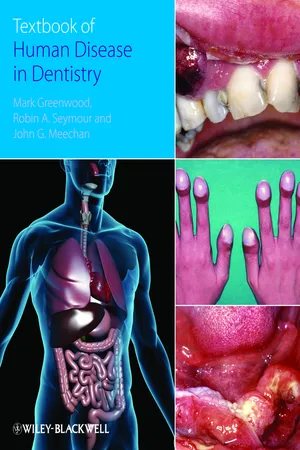
- English
- ePUB (mobile friendly)
- Available on iOS & Android
Textbook of Human Disease in Dentistry
About This Book
The Textbook of Human Disease in Dentistry is a comprehensive resource for all students of dentistry that provides uniquely integrated coverage of medicine, surgery, pharmacology, therapeutics, pathology and microbiology. It aims to provide its readers with the medical context of dentistry, to promote better understanding of how to provide effective dental treatment to patients affected by diseases and conditions.
The Textbook of Human Disease in Dentistry is structured around the systems of the body and includes chapters on immunological disease, cardiovascular diseases, respiratory medicine, gastroenterology, dermatology, musculoskeletal disorders and neurological and special senses. A key aspect of the book is the relevance of particular diseases and/or their drug treatment to dentistry and in turn to patient dental management. Additional chapters are therefore provided on topics such as clinical examination and history taking, inflammation and anti-inflammatory drugs, infection control, pain and anxiety control, and care of the elderly.
Filled with useful features and written in a lucid and accessible style, this book will provide its readers with a sound and accessible grounding in human diseases and their drug treatment and how they relate to dental care.
- Includes sections on all major diseases and conditions, describing aetiology, symptoms and treatment
- Places dentistry in a medical context, providing guidance on examination and treatment protocols
- Features information on drug treatment and planning dental care around it
- Illustrated with helpful clinical photographs, showing diseases and conditions
Frequently asked questions
Information
1
Clinical examination and history taking
Components of a medical history
- Enable the formulation of a differential diagnosis or diagnosis
- Put the patient’s disease process into the correct medical and social context
- Establish a rapport with the patient.
Presenting complaint
History of the presenting complaint
- Site
- Character, e.g. tight/band-like (in the chest suggestive of cardiac origin)
- Does the pain radiate anywhere?
- Onset – sudden or gradual
- Severity (ask the patient to rate on a scale of 1–10, with 10 being the most severe)
- Duration
- Exacerbating/relieving factors (including the use and efficacy of medication)
- Preceding events or associated features
- Has the pain occurred before/is it getting better or worse?
Past medical history
|
|
|
|
|
|
|
|
|
Allergies
Past dental history
Drugs
Social history
- Smoking behaviour
- Alcohol consumption – type and quantity
- Occupation (or previous occupation if retired)
- Home circumstances – a brief description of the residence, e.g. a house, flat or sheltered accommodation. Who else lives in the household?
Family history
Psychiatric history
General questions
- Appetite
- Weight loss
- Fevers
- The presence of lumps or bumps
- Any rashes or itchy rashes
- Lethargy or fatigue.
Cardiovascular system
- Chest pain (a differential diagnosis is given in Chapter 19)
- Dyspnoea – difficult or disordered breathing (beware of co-existing/alternative respiratory causes)
- If dyspnoea on exertion, try and quantify in terms of metres walked or stairs climbed before dyspnoea occurs
- Paroxysmal nocturnal dyspnoea (waking up in the night feeling breathless – Chapter 5)
- Orthopnoea (breathlessness on lying flat – Chapter 5)
- Ankle oedema – beware of other possible causes of lower limb swelling
- Palpitations (an awareness of the beating of the heart)
- Calf claudication (distance walked until pain occurs in the ‘calf’ muscles of the leg is referred to as the claudication distance).
Respiratory system
- The presence of a cough and its duration
- Whether the cough is productive of sputum or not
- Haemoptysis (coughing up blood)
- Wheeze.
Gastrointestinal system
- Indigestion
- Nausea or vomiting
- Dysphagia (difficulty swallowing)
- Odynophagia (pain on swallowing)
- Haematemesis (vomiting of blood) described as looking like ‘coffee grounds’
- Change in bowel habit
- Change in bowel motion, e.g. pale stool and dark urine is pathognomonic of obstructive jaundice (Chapter 7)
- Melaena is a black stool containing blood altered by gastric acid. Fresh blood indicates bleeding from further down the gastrointestinal tract.
Neurological system
- Any history of fits or faints
- Disturbance in sensation – particularly in the orofacial region
- Headache or facial pain.
Musculoskeletal system
- Gait (overlaps with neurological system)
- Pain/swelling/stiffness of joints
- Impairment of function.
Genitourinary system
Clinical observations in the clothed patient
Overall view of the patient
|
|
|
|
|
|
|
|
|
|
|
Examination of the hands
Table of contents
- Cover
- Contents
- Title Page
- Copyright
- Contributors
- Preface
- Acknowledgements
- 1 Clinical examination and history taking
- 2 Inflammation and anti-inflammatory drugs
- 3 Principles of infection and infection control
- 4 Immunological disease
- 5 Cardiovascular disorders
- 6 Respiratory disorders
- 7 Gastrointestinal disorders
- 8 Renal disorders
- 9 Neurology and special senses
- 10 Musculoskeletal disorders
- 11 Skin disorders
- 12 Endocrinology and diabetes
- 13 Haematology
- 14 Pain and anxiety control
- 15 Adverse drug reactions and interactions
- 16 General oncology
- 17 Child health
- 18 Care of the elderly
- 19 Psychiatric disorders
- 20 Medical emergencies
- Appendix
- Index